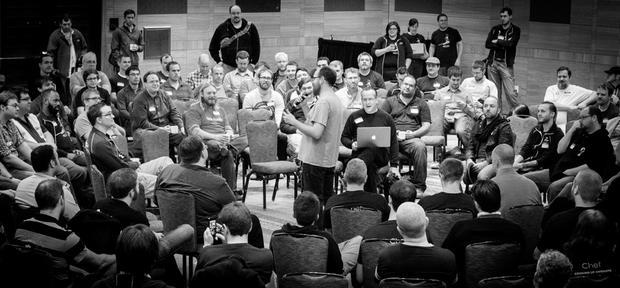IT automation company Chef launches new tool for continuous delivery of infrastructure and applications

Chef founder Adam Jacob addressing the Chef Community Summit in 2013.
Image: Chef
chef2.jpg

Jesse Robbins, founder of the Velocity Conference, once wrote a blog post about how it would take three months to fully automate a company's IT infrastructure. Adam Jacob, whose background was in systems administration, and his team responded to that blog post and told him they could do it in 24 hours.
So, Robbins joined the founding team and they set out to build a company called OpsCode, which rebranded as Chef Software in December 2013. Chef automates IT infrastructure by managing server applications, utilities, and their configurations.
Chef is available as open source, or an enterprise product, and cleared 14 million total downloads last year. The company has some big name customers such as Intercontinental Hotels Group, Disney, Nordstrom, Target, Yahoo, and Facebook.
"Chef, at a fundamental level, is a framework more than anything else. It allows you to write little snippets that tell it how you expect your system to look," said Phil Dibowitz, a production engineer at Facebook. "Then, what it does, it looks at that and compares the state of the current system to the state you desire it to be in and it figures out how to make your system look like that. It's called convergence."
Those little "snippets" that Dibowitz is referring to are called "recipes" in the Chef ecosystem. Users write recipes to tell Chef how they want certain systems to look or operate. Recipes can also be grouped into "cookbooks" to perform together in certain order.
To build on the success of its automation platform, on Wednesday, April 1, Chef announced Chef Delivery. A press release from Chef described it as "a new DevOps workflow product that for the first time enables the continuous delivery of infrastructure, runtime environments - including containers - and applications." Chef Delivery is available today through an invitation system.
By automating these changes, it better positions systems administrators and developers to deploy infrastructure changes and applications faster. Chef Delivery extends the Chef platform by adding a shared workflow pipeline, collaboration platform, enhanced analytics, scalable architecture, and ecosystem integration with tools such as AWS, Azure, and Docker.
"Delivery is our first path at building that workflow that we've seen really work both in these huge enterprise companies and in the big web, and building a product that really accelerates the time it takes to start that journey from being the company you are now to the company you want to be in a couple years," Jacob said.

Image: Chef
chef1.jpg

Before Chef, Jacob was working as a systems administrator. He worked with dot-com companies in the late 1990s and watched many of them grow by acquisition.
So, he started a consulting company to help companies build fully automated infrastructure. They kept the clients on a retainer, and the plan was that they would just build the same base of automation so the retainer portion wouldn't get too out of hand. But, having to repeat the process became difficult to maintain, and they weren't getting what they thought they would out of the repeatable automation. After a while, it came to a head.
"Either we could take a crack at trying to write a new software that would let us do that, and see if it worked, or we could just go get jobs," Jacob said. And, since we didn't really want to go get jobs, we decided to take the time to take a crack at it."
Jacob started building the tool as part of his consultancy, but encouragement from peers at the Velocity Conference, around the time he met Robbins, showed him that it could grow well beyond his work as a consultant. He open-sourced it and the community began to grow.
According to Lucas Welch, Chef's director of communications, the company did some VC funding and OpsCode rebranded as Chef Software after Series B round. Today, they have about 70,000 registered contributors for their open-source community and more than 700 paying customers for their enterprise version.
The commercial version of the software is available as a hosted version or on-premise. With the hosted version, they host the software and keep all the data. Users can access it but it doesn't live in their infrastructure. The hosted version is usually sought out by SMBs, Welch said, while the on-premise version is typically adopted by big enterprises.
Chef is also a very flexible tool. When Dibowitz began migrating his assets to Chef, there was an issue with the way it was set up to handle a specific dataset. He and his team were able to override that feature with only 20 lines of code and then customize the tool to fit their needs.
"Being able to just move that fast, and roll out a change to the core tool, without even having to roll out a new version of the software meant that we could move really, really fast, which is really important at Facebook," Dibowitz said.
Chef is based in Seattle, but it has offices in London, San Francisco, and Atlanta, and it has over 200 employees. Annual recurring revenue (ARR) grew 192% in Q4 2014, and the company just announced a new go-to market partnership with Microsoft, to complement the similar partnership they have with HP.

